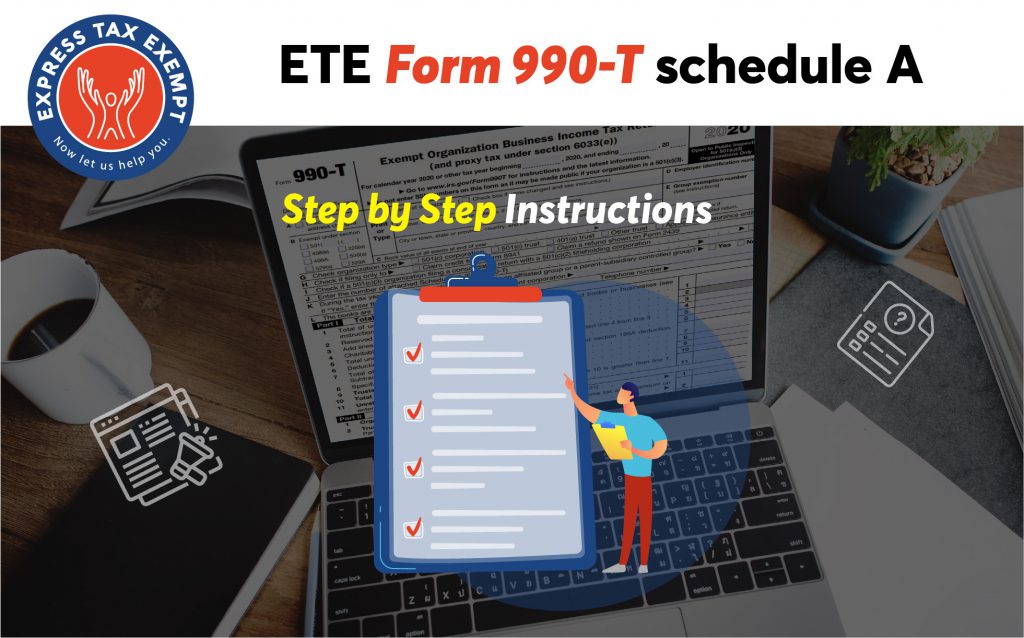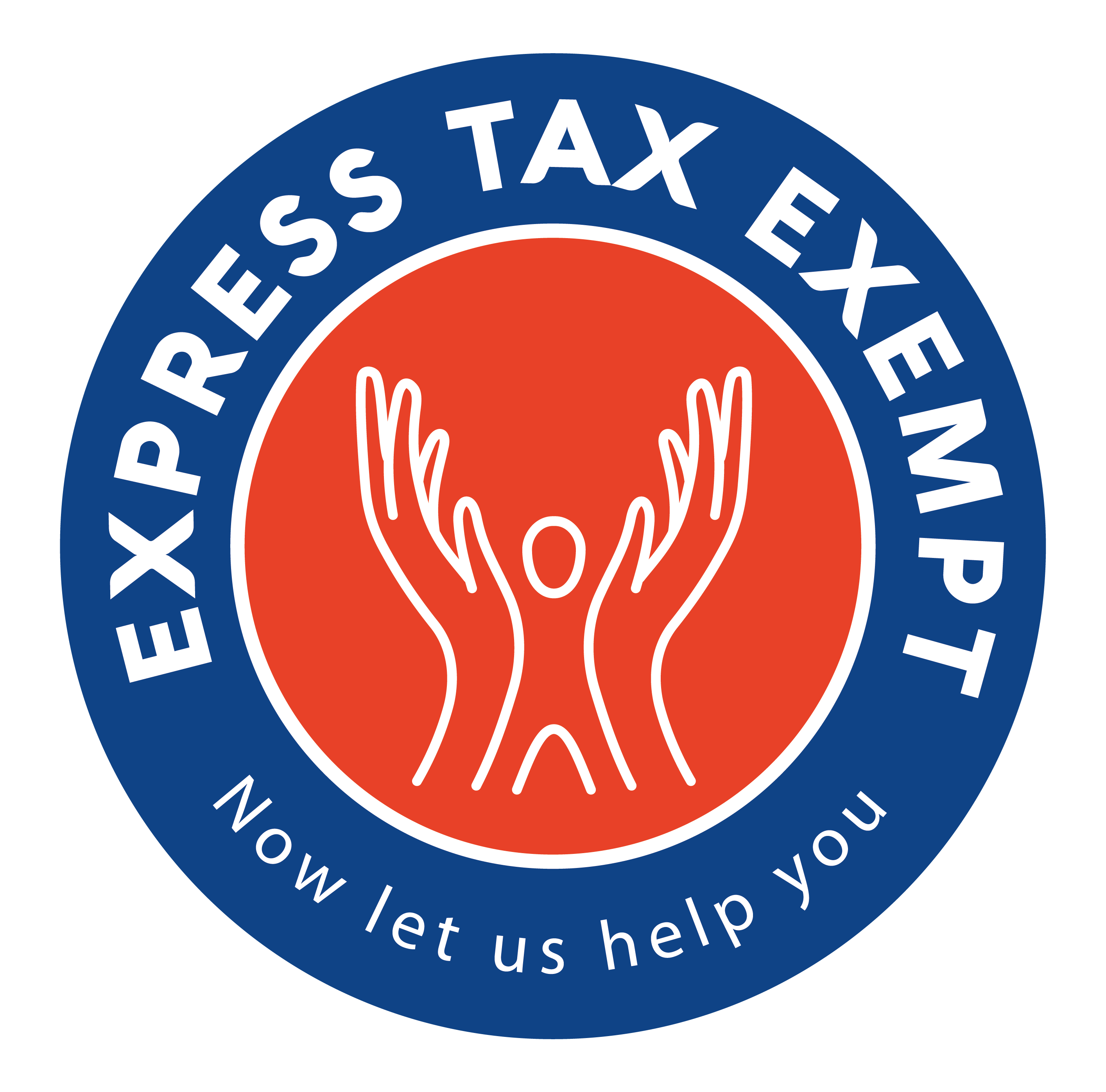Filing Form 990-T? Follow this helpful guide to complete your Form 990-T Schedule A

Form 990-T, Exempt Organization Business Income Tax Return, is used to report unrelated business income and tax liabilities. Exempt organizations that file Form 990, 990-EZ, or 990-PF and have a gross income of $1,000 or more from unrelated businesses for the tax year must file Form 990-T. Along with Form 990-T, your organization is required to attach at least one Schedule A.
We know filing these returns can be confusing and burdensome. However, using an IRS-authorized e-filing service such as ExpressTaxExemt can make filing your annual returns straightforward and painless. ExpressTaxExempt will always provide our clients with a secure and accurate filing experience. With ExpressTaxExempt, the days of worrying about your organization’s IRS compliance are no more!
If your organization is required to file Form 990-T and attach schedule A, you came to the right place! When you e-file IRS Form 990-T with ExpressTaxExempt we will provide you with helpful instructions to make your filing process quick and easy.
Here is an overview of Schedule A and step-by-step instructions on how to file Schedule A:
What is Form 990-T Schedule A?
Form 990-T Schedule A is filed by exempt organizations to report income and allowable deductions from unrelated trades or businesses. Tax-Exempt Organizations are required to attach Form 990-T Schedule A if they engage in one or more unrelated trade or businesses.
For each unrelated trade or business, an organization participates in, there must be a separate “Schedule A” attached to the return.
Each separate trade or business may be classified by a 2-digit, North American Industry Classification System (NAICS) code. Using this 2-digit code, the IRS will broadly recognize 20 separate business activities requiring a separate schedule A.
Step-By-Step Instructions for Completing Schedule A
There are 11 different sections within Schedule A. It is important you read Schedule A carefully because not every organization will need to complete all 11 sections.
Part I – Unrelated Trade or Business Income
Part one of Schedule A consists of lines 1-13 which cover information about the unrelated business income your organization acquired for the tax year.
- In this section, you should enter the values of gross receipts or sales, costs of goods, unrelated business income, investment income, and other income in the following columns:
- Income
- Expenses
- Net
Part II – Deductions Not Taken Elsewhere
In part two of Schedule A, lines 1-18 require information about the various expenses and contributions that your organization made for the taxable year. This includes compensations of officers, directors, trustees, salaries, wages paid, employee benefit programs, and other deductions.
- In line 15 (total deductions), add the values of lines 1 through 14 and enter their sum
- In line 18 (unrelated business taxable income) you can calculate your unrelated business taxable income by subtracting line 17 from line 16 and entering the value.
Part III – Costs of Goods Sold
Part three of Schedule A requires the value of the difference in inventory from the beginning of your organization’s tax year to the end.
- On line 8 of Schedule A, enter the value for the cost of goods sold
Part IV – Rent Income (from real property and personal property leased with real property)
Part four requires information about the gross rental income received or accrued by your organization for the taxable year. All organizations that have applicable rent income, other than section 501(c)(7), (9), and (17) organizations, should complete Schedule A, part IV.
- Organizations should enter gross rents on Schedule A, part I, line 6
- Organizations should enter applicable expenses on Schedule A, Part II, lines 1 through 14
Part V – Unrelated Debt-Financed Income
Part five of Schedule A is used to compute unrelated debt-financed income described in sections 512(b)(4) and 514 from debt-financed properties. Part V only reports on this income when it doesn’t constitute income from the conduct of an unrelated trade or business and isn’t specifically taxable under other provisions of the code.
- This includes income such as taxable rents from personal property leased with real property (reportable on Schedule A, part IV and Schedule A, part I, line 6), or taxable interest, annuities, royalties, and rents from a controlled entity (reportable on Schedule A, part VI and Schedule A, Part 1, line 8).
Part VI – Interest, Annuities, Royalties, and Rents from Controlled Organizations
Part six of Schedule A requires information regarding interest, annuities, royalties, and rents from controlled organizations.
- Under section 512(b)(13), interest, annuities, royalties, and rents received or accrued (directly or indirectly) by a controlling organization from a controlled organization are subject to tax. These amounts are still taxable, whether or not the activity that the controlling business conducts to earn them is regularly conducted or is a trade or business.
Part VII – Investment Income of Section 501(c)(7), (9), or (17) Organization
Part seven requires information about your organization’s investment income. You should report all income made from investments in securities and other similar investment income from nonmembers. This includes 100% of income and directly related expenses from debt-financed property.
Part VIII – Exploited Exempt Activity Income, Other Than Advertising Income
Section eight requires information about your organization’s exploited exempt activity income.
- Exempt organizations with gross income from an unrelated trade or business activity that exploits an exempt activity (other than periodical advertising-income reportable in Schedule A Part IX) must complete this part of 990-T Schedule A.
Part IX – Advertising Income
Lines 1 through 8 of Part nine require information about your organization’s advertising income. Exempt organizations that earned gross income from advertising in exempt organization periodicals must complete Schedule A, Part IX of this form.
Part X – Compensation of Officers, Directors, and Trustees
Part ten requires information on the compensation made to your organization’s officers, directors, and trustees
- Enter the required details about your officers, directors, and trustees in the following columns
- Name
- Title
- Percentage of time devoted to business
- Compensation attributable to unrelated business
Part XI – Supplemental Information
In the final section of Schedule A, part 11, you will be required to provide information on your organization’s operations. You can provide this information on lines that don’t have an embedded attachment, information to supplement embedded attachments, or any other information about amounts reported on Schedule A.
- An example of this would be if your organization associated its unrelated trade or business activity with a different NAICA or Business Activity Code during a prior year than the one shown on Schedule A for the tax year you are filing in. If this is the case, you can use Part XI to provide an explanation of your organization’s operations.
ExpressTaxExempt
Although that may seem like a lot of information, ExpressTaxExempt is here to assist you during your entire filing process. We will provide you with helpful instructions to make your filing process quick and easy. We also have a dedicated live customer support team that is available via email, phone, and live chat and is always happy to help!
When you e-file Form 990-T with ExpressTaxExempt you can attach Schedule A for FREE. Our internal audit check feature will review your Form for any errors, and ensure the transmission of error-free returns. Then, you can transmit your Form to the IRS securely.
As an IRS authorized software, ExpressTaxExempt will provide a safe, secure, and accurate filing experience for all of our clients.
Related Posts
-
 Form 990-T Redesigned for 2020: What Tax-Exempt Organizations Need to Know
No Comments | Jul 29, 2021
Form 990-T Redesigned for 2020: What Tax-Exempt Organizations Need to Know
No Comments | Jul 29, 2021 -
 ExpressTaxExempt Now Supports E-filing of Form 990-T
No Comments | Nov 15, 2021
ExpressTaxExempt Now Supports E-filing of Form 990-T
No Comments | Nov 15, 2021 -
 What Exempt Organizations Need to Know About Form 990-T
No Comments | Aug 18, 2021
What Exempt Organizations Need to Know About Form 990-T
No Comments | Aug 18, 2021 -
 A Simple Guide To Completing IRS Form 990-T
No Comments | Aug 24, 2021
A Simple Guide To Completing IRS Form 990-T
No Comments | Aug 24, 2021
